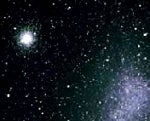The Hubble Space Telescope had been used to conduct the most complete search yet. In 1999, astronomer Ron Gilliland of the Space Telescope Science Institute (STScI) in Baltimore and his colleagues probed the southern globular cluster 47 Tucanae, the second brightest globular in the sky. They tracked some 34,000 stars for 8 consecutive days, looking for any star that showed a tiny dip in brightness that would indicate a large, close-orbiting planet was transiting it. The researchers expected to find a few such “hot Jupiters.” They found none.
The study didn’t prove that planets can’t exist in globulars. After all, 47 Tucanae is just one globular. But all the Milky Way’s globulars were born about 13 billion years ago, when the galaxy was just forming, and the infant galaxy didn’t possess many of the heavy elements thought necessary to form planets. Presumably, what transpired in 47 Tucanae likely would hold true in other globulars. Of course, the observations could reveal only hot Jupiters, so there was still hope that some planets could exist in globular clusters — a hope ultimately realized with the observations of M4.











